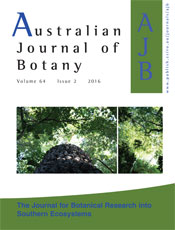Australian Journal of Botany
Volume 64
Number 2 2016
The study of tree architecture has great ecological importance, helping understand forest dynamics. The vertical light gradient influences tree species that reach different heights in maturity. So we tested whether the stratum to which a species belongs has influence on tree architecture, by studying shapes of four species within height classes and the light environment surrounding them. The fact that species belong to different strata of the forest influenced all species architecture and the analysis within height classes was shown to be effective.
Nutrient distribution, cycling and nutrient use efficiency in an Australian subtropical rainforest not limited by nutrients was reported. Initial aboveground forest biomass was ~334 t ha–1 of organic matter and ha and a net accumulation rate of 1.03 t ha–1 year–1. Net primary productivity was 13.0–14.6 t ha–1 year–1. Estimates of quantities nutrient return, requirement and uptake of N, P, K, Ca and Mg were reported. Nutrient use efficiency (NUE) was low.
Cyclical dynamics in vegetation help create the environmental heterogeneity which allows many species to co-exist. We found out that patterns in subalpine vegetation dominated by Richea acerosa were the result of cyclic succession related to the growth and senescence of this prickly shrub. This phenomenon may occur with other alpine/subalpine shrubs.
Understanding the reproductive biology is essential for successful domestication and genetic improvement of Casuarina equisetifolia, an economically and environmentally important species. Study on floral biology, breeding system and progeny performance using grafted ramets revealed pollen limitation under open pollination and inbreeding depression under selfing. The high selfing rate (42%) of monoecious individuals according to microsatellite-based estimates further suggests that monoecious C. equisetifolia individuals are self-compatible and that the breeding system should be classified as facultative xenogamy.
Tree decline is a worldwide phenomenon that has the potential to alter reproductive cycles of individual trees, yet this topic has little been explored. Canopy condition of Eucalyptus wandoo was monitored over 12 months in Dryandra State Forest and Wandoo Conservation Park in Western Australia. Links between tree decline and the reproductive capacity of E. wandoo were found, as well as relationships between time since last fire and weather conditions.
Exotic herbivores, including European rabbits, are known to damage Australian native plants but it is unclear what level of control is necessary to minimise that damage. This study presents and validates a simple methodology for measuring the impact of rabbit density on native trees and shrubs, for use in setting target densities for plant biodiversity protection. Rabbits suppressed recruitment of palatable species at <1 rabbit ha–1, threatening native plant community composition at much lower densities than is widely recognised.
The perennial warm-season grass Paspalum vaginatum is studied as a model plant to identify the permanent morphological features that characterise the architectural unit of this species, to describe its developmental dynamics, and to explore the morphological basis of its extraordinary plasticity and adaptability to multiple ecological conditions.
Ten morphology traits of 28 natural and introduced populations of Casuarina equisetifolia subsp. equisetifolia L. seedlings were studied at two nursery sites in China. Univariate and multivariate analyses showed varying stability of the traits across the nursery sites and marked geographic variation patterns among provenances and land races from Oceania, Asia and Africa that that are broadly consistent with those obtained in past field studies.
Mistletoes tripled in numbers over about 13 years within unfragmented forest. The increase was limited by intensive logging but was unaffected by low intensity prescribed burns. Rather than indicating an ecological imbalance, the increase may be part of a natural cycle of boom and bust, with populations crashing in severe wildfires.




